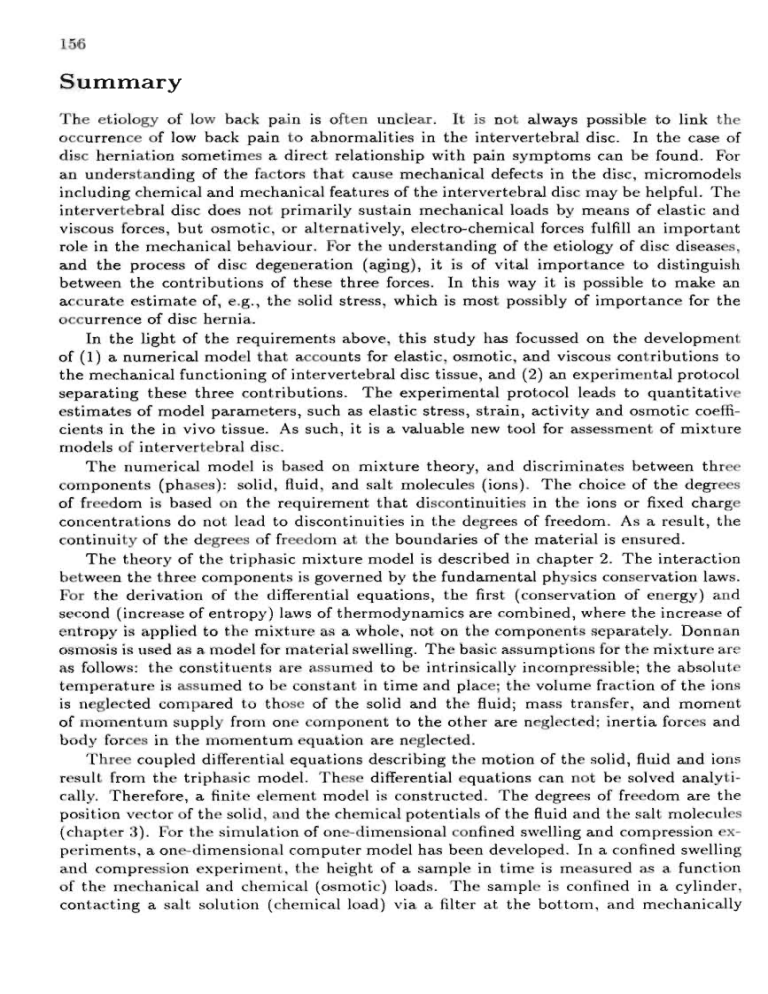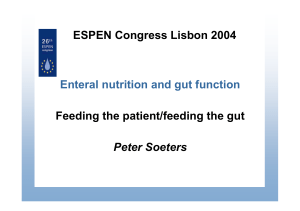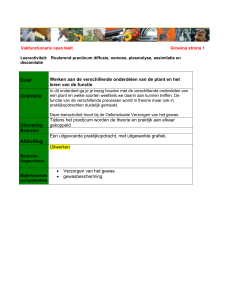
156
Summary
The etiology of low back pain is often unclear. It is not always possible to link the
occurrence of low back pain to abnormalities in the intervertebral disc. In the case of
disc herniation sometimes a direct relationship with pain symptoms can be found. For
an understanding of the factors that cause mechanical defects in the disc, micromodels
including chemical and mechanical features of the intervertebral disc may be helpful. The
intervertebral disc does not primarily sustain mechanical loads by means of elastic and
viscous forces, but osmotic, or alternatively, electro-chemical forces fulfill an important
role in the mechanical behaviour. For the understanding of the etiology of disc diseases,
and the process of disc degeneration (aging), it is of vital importance to distinguish
between the contributions of these three forces. In this way it is possible to make an
accurate estimate of, e.g., the solid stress, which is most possibly of importance for the
occurrence of disc hernia.
In the light of the requirements above, this study has focussed on the development
of (1) a numerical model that accounts for elastic, osmotic, and viscous contributions to
the mechanical functioning of intervertebral disc tissue, and (2) an experimental protocol
separating these three contributions. The experimental protocol leads to quantitative
estimates of model parameters, such as elastic stress, strain, activity and osmotic coefficients in the in vivo tissue. As such, it is a valuable new tool for assessment of mixture
models of intervertebral disc.
The numerical model is based on mixture theory, and discriminates between three
components (phases): solid, fluid, and salt molecules (ions). The choice of the degrees
of freedom is based on the requirement that discontinuities in the ions or fixed charge
concentrations do not lead to discontinuities in the degrees of freedom. As a result, the
continuity of the degrees of freedom at the boundaries of the material is ensured.
The theory of the triphasic mixture model is described in chapter 2. The interaction
between the three components is governed by the fundamental physics conservation laws.
For the derivation of the differential equations, the first (conservation of energy) and
second (increase of entropy) laws of thermodynamics are combined, where the increase of
entropy is applied to the mixture as a whole, not on the components separately. Donnan
osmosis is used as a model for material swelling. The basic assumptions for the mixture are
as follows: the constituents are assumed to be intrinsically incompressible; the absolute
temperature is assumed to be constant in time and place; the volume fraction of the ions
is neglected compared to those of the solid and the fluid; mass transfer, and moment
of momentum supply from one component to the other are neglected; inertia forces and
body forces in the momentum equation are neglected.
Three coupled differential equations describing the motion of the solid, fluid and ions
result from the triphasic model. These differential equations can not be solved analytically. Therefore, a finite element model is constructed. The degrees of freedom are the
position vector of the solid, and the chemical potentials of the fluid and the salt molecules
(chapter 3). For the simulation of one-dimensional confined swelling and compression experiments, a one-dimensional computer model has been developed. In a confined swelling
and compression experiment, the height of a sample in time is measured as a function
of the mechanical and chemical (osmotic) loads. The sample is confined in a cylinder,
contacting a salt solution (chemical load) via a filter at the bottom, and mechanically
Summary
157
loaded by means of a piston, placed on top of the sample. From the computer fits of the
confined swelling and compression experiments, chemo-mechanical parameters, such as
activity coefficients, permeability and diffusion coefficients, effective stress and stress free
height, are determined.
The equilibrium situations and the compression transient of the experiments are fitted
easily. However, it is not possible to fit the swelling transient concurrently with the
compression transient. It appears that the diffusion coefficient is overestimated, whereas
the rest of the parameter values is within the physiological range.
The radial variation of the permeability in the annulus fibrosus of the intervertebral
disc has been investigated in chapter 4. Fitting a biphasic analytical solution to the compression transient of a confined swelling and compression experiment, results in a biphasic
permeability coefficient, and aggregate modulus. The biphasic permeability coefficient increases from outer to inner annulus. This result is corroborated by results from chapter
5. For the aggregate modulus as a function of radial position there is no conclusive finding: the aggregate modulus can either decrease (chapter 4), or increase (chapter 5) from
outer to inner annulus. The biphasic permeability coefficient and aggregate modulus are
deformation dependent.
In chapter 5 a series of experiments is designed to determine the in vivo chemomechanical properties of canine annulus fibrosus. The protocol for the determination of
these properties is based on the division of tissue fluid into extra- and intrafibrillar water
(two fluid compartments), and the use of Donnan osmotic theory for the determination of
the osmotic pressure. The experiments used in the protocol are: one-dimensional confined
swelling and compression experiments, measurement of fixed charges using radioactive
labelling, measurements of hydroxyproline and fluid content. Research has revealed that
part of the tissue water is bound to the collagen fibrils. This fraction is not available for
the proteoglycans and is called the intrafibrillar fraction. The size (fluid content) of the
intrafibrillar compartment is determined by the collagen (hydroxyproline) content and
the osmotic pressures.
From the equilibrium situations of the confined swelling and compression experiments,
a relationship between the effective stress (a measure for the solid stress), and the strain is
determined. In vivo values of chemo-mechanical quantities, such as fixed charge density,
fluid fraction, collagen content, osmotic and activity coefficients, effective stress and stress
free length, are determined. Bi- and triphasic permeability coefficients are determined
from fits of the compression transient, using the biphasic analytical solution (chapter 4),
and the one-dimensional computer model of chapter 3 respectively. For the triphasic
permeability coefficient also an estimate of the in vivo value is made. The triphasic
computer model is also used for the determination of chemo-mechanical parameters based
on a single fluid compartment, as was done in chapter 3. The computer model, in contrast
to the analysis protocol for the equilibrium situations, does not discriminate between
extra- and intrafibrillar water.
For the stress-strain relationship, we have chosen for a linear relationship between
the effective 2nd Piola-Kirchhoff stress and the Green-Lagrange strain. This choice has
important consequences for the stress and strain that are found for the in vivo situation. Using the linear relation, it is found that in the in vivo situation, the solid is
under compression in the radial direction. The analysis based on extra- and intrafibrillar
compartments yields different results from the single fluid compartment results of the
158
computer simulation. The extent of the difference depends on the amount of water that
is bound by the collagen fibrils. The analysis of the results give no indication for the
introduction of chemical expansion stress to account for material swelling. The triphasic
in vivo permeability coefficient also increases from outer to inner annulus, as does the
biphasic permeability coefficient.
The protocol presented in chapter 5 is a first approach to gain insight in the separate
influence of chemo-mechanical quantities on the mechanical behaviour of cartilaginous
tissues. The division of the tissue fluid in two fluid compartments requires the definition
of additional activity and osmotic coefficients. The fluid in the intrafibrillar compartment
can as a fist approach be defined as having identical activity and osmotic coefficients as
the external fluid, as was done in this study. The existing triphasic model, based on
Donnan osmosis, needs to be improved, so that it is capable of fitting swelling transients
with realistic diffusion coefficients. A start to this is the introduction of electro-chemical
potentials for the cations and anions separately (quadriphasic theory). Subsequently, the
concept of separation of the tissue water into two fluid compartments can be combined
with the quadriphasic theory.
Samen vat ting
159
Samenvatting
De oorzaken van lage rugpijn zijn in veel gevallen onduidelijk. Het is niet altijd mogelijk om een link te leggen tussen het ontstaan van lage rugpijn en het optreden van
abnormaliteiten in de tussenwervelschijf. In het geval van een hernia kan soms een direct verband worden gevonden tussen de pijnsymptomen en de defecte tussenwervelschijf.
Om te doorgronden hoe het mogelijk is dat bepaalde mechanische defecten aan de tussenwervelschijf optreden, is het nuttig om gebruik te maken van chemo-mechanische micromodellen van de tussenwervelschijf. De tussenwervelschijf draagt zijn mechanische belasting niet alleen via elastische en viskeuze krachten, maar osmotische, of electrochemische
krachten spelen hierbij een belangrijke rol. Voor een goed begrip van de etiologie van
tussenwervelschijfziekten en het proces van degeneratie van de tussenwervelschijf, is het
van belang de bijdragen van deze drie krachten te kunnen scheiden. Op deze manier kan
bijvoorbeeld een goede inschatting gemaakt worden van de spanning die optreedt in de
vaste stof, wat zeer waarschijnlijk een belangrijke rol speelt bij hernia.
In het kader van het bovenstaande, heeft het onderzoek beschreven in dit proefschrift
zich gericht op de ontwikkeling van (1) een numeriek model dat de elastische, osmotische
en viskeuze krachten scheidt en (2) een experimenteel protocol, waarmee de bijdragen van
de verschillende krachten bepaald kunnen worden. Het is mogelijk om met het protocol
schattingen te bepalen van in vivo waarden van modelparameters, zoals elastische spanning, rek, activiteits- en osmotische coefficienten. Dit maakt het een nieuw waardevol
instrument voor het testen van mengselmodellen van de tussenwervelschijf.
Het numerieke model is gebaseerd op de mengseltheorie, waarbij onderscheid gemaakt
wordt tussen drie componenten (fasen): vaste stof, vloeistof of water en zoutmoleculen (ionen). Het kiezen van de vrijheidsgraden is gebaseerd op de vereiste, dat discontinuiteiten
in de ionenconcentraties of gebonden ladingsdichtheid, niet leiden tot discontinuiteiten in
de vrijheidsgraden. Hiermee is de continuiteit van de vrijheidsgraden aan de grenzen van
het materiaal verzekerd.
De drie fasen mengseltheorie wordt beschreven in hoofdstuk 2. De interactie tussen
de drie componenten is onderworpen aan de fundamentele behoudswetten van de fysica.
Voor het afleiden van de differentiaalvergelijkingen van het mengsel worden de eerste (behoud van energie) en tweede (toename van entropie) hoofdwet van de thermodynamica
gebruikt, waarbij de toename van entropie van toepassing is op het totale mengsel, niet
op de afzonderlijke componenten. Als model voor het zwellen van het materiaal wordt
Donnan osmose gebruikt. De belangrijkste aannames t.a.v. het model zijn: de componenten zijn intrinsiek incompressibel; de absolute temperatuur is constant in tijd en
plaats; de volumefractie van de ionen wordt verwaarloosd in vergelijking met de volumefracties van de vaste stof en vloeistof; overdracht van massa en impulsmoment van de
ene component op de andere wordt verwaarloosd; traagheids- en lichaamskrachten in de
impulsvergelijking worden verwaarloosd.
Uit het drie fasen mengselmodel resulteren drie gekoppelde differentiaalvergelijkingen, die de beweging van de vaste stof, vloeistof en ionen beschrijven. Deze differentiaalvergelijkingen kunnen niet analytisch opgelost worden. Voor het oplossen van de
vergelijkingen is derhalve gekozen voor een eindige-elementenmodel. De vrijheidsgraden
zijn de verplaatsingsvector van de vaste stof en de chemische potentialen van de vloeistof
en de zoutmoleculen (hoofdstuk 3). Voor de simulatie van een-dimensionale zwel- en
160
consolidatie-experimenten is een een-dimensionaal computermodel ontwikkeld. In een
zwel- en consolidatie-experiment wordt de hoogte van een proefstuk in de tijd gemeten
als functie van de mechanische en chemische (osmotische) belasting. Het proefstuk zit
opgesloten in een cylinder en is via een filter aan de onderkant in aanraking met een zoutoplossing (chemische belasting). Via een zuiger, die op het proefstuk rust, wordt het proefstuk mechanisch belast. Uit de computerfits van de zwel- en consolidatie-experimenten
worden chemo-mechanische parameters, zoals activiteitscoefficienten, permeabiliteits- en
diffusiecoefficient, effectieve spanning e.i spanningsvrije lengte bepaald.
De evenwichtssituatiesen de consolidatietransient van de experimenten kunnen makkelijk gefit worden. Het blijkt echter niet mogelijk om de zweltransient gelijktijdig met de
consolidatietransient te fitten. Het blijkt ook dat de diffusiecoefficient overschat wordt,
terwijl de rest van de parameterwaarden zich in het fysiologische bereik bevinden.
De radiale variatie van de permeabiliteit in de annulus fibrosus van de tussenwervelschijf
is onderzocht in hoofdstuk 4. De consolidatietransient van zwel- en consolidatie-experimenten
is gefit met een analytische twee-fasen oplossing. Uit die oplossing zijn de twee-fasen
permeabiliteitscoefficient en de compressiemodulus (aggregate modulus) bepaald. De
permeabiliteitscoefficient neemt toe in radiale richting van buiten naar binnen. Dit resultaat wordt versterkt door de resultaten uit hoofdstuk 5, waar hetzelfde gevonden wordt.
Voor de compressiemodulus spreken de resultaten van hoofdstuk 4 en 5 elkaar tegen. De
resultaten van hoofdstuk 4 geven een toename van binnen naar buiten, terwijl uit de
resultaten van hoofdstuk 5 het tegenovergestelde volgt. De twee-fasen permeabiliteit en
de compressiemodulus zijn afhankelijk van de vervorming.
In hoofdstuk 5 zijn een serie experimenten gedaan om de in vivo chemo-mechanische
eigenschappen van de annulus van tussenwervelschijf van de hond te bepalen. Uitgangspunten in het protocol voor de bepaling van deze eigenschappen zijn de opdeling
van de vloeistof in extra- en intrafibrillair water (dubbel vloeistof compartiment) en het
gebruik van de theorie van Donnan voor de berekening van de osmotische druk. De
experimenten die aan de basis van het protocol liggen zijn: een-dimensionale zwel- en
consolidatie-experimenten, meting van gebonden ladingen m.b.v. radioactieve labelling,
meting van hydroxyproline en hoeveelheid vloeistof. Onderzoek heeft aangetoond, dat
een deel van het weefselwater gebonden is aan de collageen fibrillen. Deze fractie water is
niet toegankelijk voor de proteoglycanen en wordt de intrafibrillaire fractie genoemd. De
grootte (hoeveelheid vloeistof) van het intrafibrillaire compartiment wordt bepaald door
het collageen (hydroxyproline) gehalte en de osmotische drukken.
Uit de evenwichtssituaties van de zwel- en consolidatie-experimenten is een relatie
tussen de effectieve spanning (een maat voor de vaste stof spanning) en de rek bepaald.
Daarnaast zijn in vivo waarden van chemo-mechanische grootheden, zoals gebonden ladingsdichtheid, vloeistoffractie, collageen gehalte, osmotische en activiteitscoefficienten,
effectieve spanning en spanningsvrije lengte, bepaald. Uit de consolidatietransienten
zijn waarden voor de twee- en drie-fasen permeabiliteitscoefficienten bepaald. Voor de
twee-fasen permeabiliteitscoefficient is de twee-fasen analytische oplossing uit hoofdstuk
4 gebruikt, voor de drie-fasen permeabiliteitscoefficient de een-dimensionale computersimulatie uit hoofdstuk 3. Voor de drie-fasen permeabiliteitscoefficient is ook een schatting
voor de in vivo waarde gemaakt. De computersimulatie is tevens gebruikt om andere
chemo-mechanische parameters voor een enkel vloeistofcompartiment te bepalen, als in
hoofdstuk 3. In tegenstelling tot het analyseprotocol voor de evenwichtssituaties, maakt
Samenvatting
161
het computermodel geen onderscheid tussen extra- en intrafibrillair water.
Bij de bepaling van de relatie tussen spanning en rek is gekozen voor een lineair
verband tussen de effectieve 2de Piola-Kirchhoff spanning en de Green-Lagrange rek.
De keuze van het spannings-rekverband heeft een belangrijke invloed op de spanning en
rek, die berekend worden voor de in vivo situatie. In het geval van een lineaire relatie,
blijkt dat in de in vivo situatie de vaste stof onder compressie is in de radiale richting.
De opdeling van vloeistof in twee (extra- en intrafibrillaire) vloeistofcompartimenten,
levert verschillende resultaten op in vergelijking met de resultaten op basis van een enkel
vloeistofcompartiment (computersimulatie). De grootte van het verschil is afhankelijk
van de hoeveelheid water, die gebonden is aan de collageenfibrillen. De analyse van de
resultaten geeft geen aanleiding tot de introductie van een chemische expansie spanning
voor het zwellen van het materiaal. Evenals de twee-fasen permeabiliteit, neemt de driefasen permeabiliteit in radiale richting in de annulus toe van buiten naar binnen.
Het protocol dat gepresenteerd is in hoofdstuk 5 is een eerste aanzet om inzicht
te krijgen in de gescheiden invloed van chemo-mechanische grootheden op het mechanisch gedrag van kraakbeenachtige weefsels. De opdeling van de weefselvloeistof in
twee vloeistofcompartimenten vereist de definitie van additionele activiteits- en osmotische coefficienten. De vloeistof in het intrafibrillaire compartiment kan als eerste benadering met identieke activiteits- en osmotische coefficienten in vergelijking met de externe vloeistof gedefinieerd worden. Deze benadering is in dit proefschrift gebezigd. Het
bestaande drie-fasen model, op basis van Donnan osmose, moet verbeterd worden, zodat het in staat is om zweltransienten te fitten met realistische diffusiecoefficienten. Een
aanzet hiertoe is de definitie van electrochemische potentialen voor de kationen en anionen
afzonderlijk (vier-fasen theorie). De vier-fasen theorie kan vervolgens met het concept van
de scheiding van het weefselwater in twee vloeistofcompartimenten uitgebreid worden.












